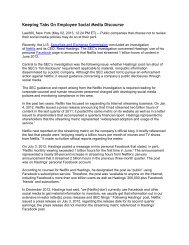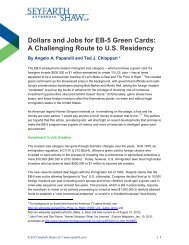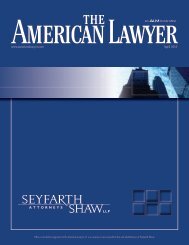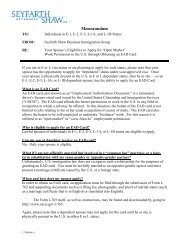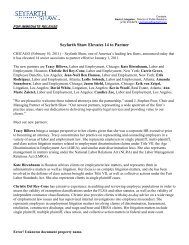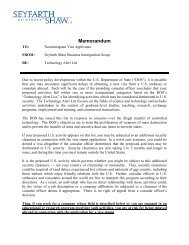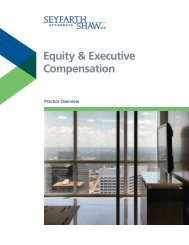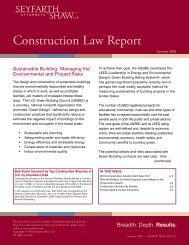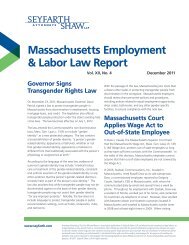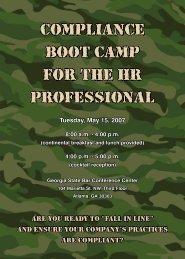Litigating California Wage & Hour and Labor Code Class Actions
Litigating California Wage & Hour and Labor Code Class Actions
Litigating California Wage & Hour and Labor Code Class Actions
Create successful ePaper yourself
Turn your PDF publications into a flip-book with our unique Google optimized e-Paper software.
In 1971, in La Sala v. American Savings & Loan Association, 441 the court held that, under<br />
the facts before it, the plaintiff should have been permitted to substitute a proper class<br />
representative for a class representative who was inadequate. A key aspect of the<br />
decision, however, was that the defendant had engaged in questionable conduct that<br />
rendered the plaintiff inadequate. More specifically, the case addressed the alleged<br />
impropriety of a fee charged by the defendant savings & loan. The defendant excused the<br />
plaintiff from paying the fee as a basis to argue that the plaintiff suffered no harm <strong>and</strong>, thus,<br />
lacked st<strong>and</strong>ing to represent a class of injured customers.<br />
The court left open the question of whether the plaintiff’s lack of any injury rendered him<br />
inadequate to represent the putative class as a matter of law, but it held that a defendant<br />
should not be able to defeat a class action by simply paying off class representatives oneby-one<br />
as they come forward:<br />
In the present case, American has waived its acceleration clause only as to [the<br />
plaintiffs]. If other borrowers bring a class action, American may again waive as<br />
to those representative borrowers, <strong>and</strong> again move to dismiss the action. Such a<br />
procedure could be followed ad infinitum for each successive group of<br />
representative plaintiffs. If defendant is permitted to succeed with such revolving<br />
door tactics, only members of the class who can afford to initiate or join litigation<br />
will obtain redress; relief for even a portion of the class would compel<br />
innumerable appearances by individual plaintiffs. 442<br />
La Sala has been interpreted to permit a plaintiff to amend the complaint to add a new<br />
class representative when the original plaintiff, although a bona fide member of the putative<br />
class, has particular traits that make him an inadequate class representative. 443 Thus,<br />
under La Sala, a plaintiff who is deemed inadequate generally can find <strong>and</strong> substitute in<br />
another class representative. 444<br />
La Sala left open the important question of whether the plaintiff may use the discovery<br />
process as a mechanism to obtain contact information for other putative class members for<br />
the express purpose of asking them if they would be willing to be a substitute class<br />
441<br />
442<br />
443<br />
444<br />
5 Cal. 3d 864 (1971).<br />
Id. at 873.<br />
But see Howard Gunty Profit Sharing Plan v. Superior Court, 88 Cal. App. 4th 572, 580-81 (2001) (leave to substitute<br />
class representative may be inappropriate where trial court determines that the class representative was a “professional<br />
plaintiff” with a history of abusing the class action procedure).<br />
See, e.g., Aguiar v. Cintas Corp. No. 2, 144 Cal. App. 4th 121, 137 (2006) (“the second amended complaint may be<br />
amended once again on rem<strong>and</strong> to add another named plaintiff should it be determined that . . . [plaintiff] needs an<br />
additional, adequate representative”); Shappell Indus., Inc. v. Superior Court, 132 Cal. App. 4th 1101, 1109 (2005) (“[La<br />
Sala] demonstrate[s] that <strong>California</strong> courts recognize <strong>and</strong> preserve the rights of absent class members, even before the<br />
issue of certification has been determined”).<br />
Seyfarth Shaw LLP | www.seyfarth.com <strong>Litigating</strong> <strong>California</strong> <strong>Wage</strong> & <strong>Hour</strong> <strong>Class</strong> <strong>Actions</strong> (12th Edition) 98



